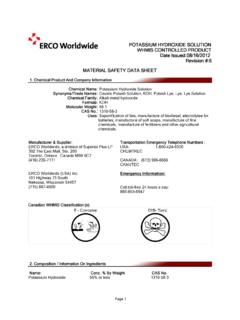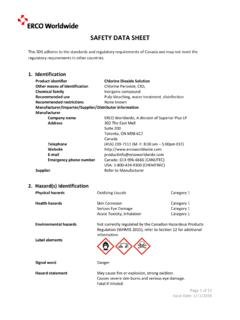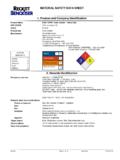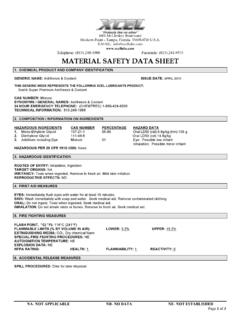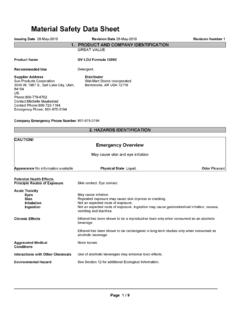Transcription of SODIUM HYPOCHLORITE SOLUTION WHMIS …
1 Page 1 sodium hypochlorite SOLUTIONWHMIS CONTROLLED PRODUCTDate Issued:06/08/2012 Revision #:3 MATERIAL safety data sheet 1. Chemical Product And Company InformationChemical Name: SODIUM HYPOCHLORITE SolutionSynonyms/Trade Names: Hypo, Bleach, Liquid bleach, Soda bleachChemical Family: Formula: NaOClMolecular Weight : No.: 7681-52-9 Uses: Used as a disinfectant and sanitizer in swimming pools, bleach for textiles and wood pulp and in effluent & Supplier:Transportation Emergency Telephone Numbers :ERCO Worldwide, a division of Superior Plus LPWanuskewin Rd.
2 & 71st StreetSaskatoon, Saskatchewan S7K 3R3(306) 931-7767 ERCO Worldwide (USA) Highway 73 SouthNekoosa, Wisconsin 54457(715) 887-4000 CANADA:CANUTEC (613) 996-6666 USA:CHEMTREC 1-800-424-9300 Canadian WHMIS Classification (s): E - Corrosive 2. Composition / Information On Ingredients Name: Conc. % By Weight CAS HYPOCHLORITE SODIUM - 15 1 - 5 7681-52-9 1310-73-2 Page 2 3. Hazard IdentificationEmergency Overview :Clear light yellow to greenish-yellow liquid with a chlorine-like (bleach) odour.
3 Does not burn. Decomposes when heated, during a fire or upon contact with acids releasing corrosive chlorine gas. During a fire, corrosive hydrogen chloride gas may also be generated. Reacts with primary and aromatic amines, ammonia and ammonium salts to form explosively unstable compounds. CORROSIVE to the eyes and skin. May cause blindness and permanent scarring. Routes of Entry :Inhalation: SODIUM HYPOCHLORITE does not easily form a vapour, but solutions decompose slowly on contact with air releasing corrosive chlorine gas.
4 Chlorine can cause severe irritation of the nose, throat and lungs, and even death, depending on the airborne concentration. Mists formed from solutions can probably cause mild to severe irritation of the nose and throat, depending mainly upon the airborne concentration and the strength of the SOLUTION . Skin Contact: SODIUM HYPOCHLORITE solutions can cause corrosive injury depending on the duration of contact, the concentration and pH of the SOLUTION . Corrosive materials are capable of producing severe burns, blistering and permanent scarring.
5 Eye Contact: SODIUM HYPOCHLORITE solutions can cause corrosive injury, depending on the concentration and pH of the SOLUTION , and the duration of contact. information. Corrosive materials are capable of causing permanent eye damage, including blindness. Ingestion: Swallowing SODIUM HYPOCHLORITE solutions can cause irritation, pain and inflammation of the mouth, throat and stomach, as well as vomiting. In severe cases, serious effects including ulceration and perforation of the gastrointestinal tract and death can of Exposure :See above.
6 Page 3 4. First Aid MeasuresSkin:Avoid direct contact. Wear chemical protective clothing, if necessary. As quickly as possible, flush with lukewarm, gently flowing water for at least 20 minutes, or until the chemical is removed. If irritation persists, repeat flushing. Under running water, remove contaminated clothing, shoes and leather goods ( , watchbands, belts). Completely decontaminate clothing, shoes and leather goods before reuse, or discard. Obtain medical advice :Avoid direct contact. Wear chemical protective gloves, if necessary.
7 Immediately flush the contaminated eye(s) with lukewarm, gently flowing water for at least 20-30 minutes, by the clock, while holding the eyelid(s) open. Take care not to rinse contaminated water into the unaffected eye or onto the face. If irritation persists, repeat flushing. Neutral saline SOLUTION may be used as soon as it is available. DO NOT INTERRUPT FLUSHING. If necessary, keep emergency vehicle waiting. Quickly transport victim to an emergency care : SODIUM HYPOCHLORITE can release corrosive chlorine gas.
8 Take proper precautions to ensure your own safety before attempting rescue. Remove source of contamination or move victim to fresh air. If breathing is difficult, oxygen may be beneficial if administered by trained personnel, preferably on a doctor's advice. DO NOT allow victim to move about unnecessarily. Symptoms of pulmonary edema can be delayed up to 48 hours after exposure. Avoid mouth-to-mouth contact by using mouth guards or shields. Immediately transport victim to an emergency care facilityIngestion:NEVER give anything by mouth if victim is rapidly losing consciousness, is unconscious or convulsing.
9 Have victim rinse mouth thoroughly with water. DO NOT INDUCE VOMITING. Have victim drink 240 to 300 mL (8 to 10 oz) of water to dilute material in stomach. If vomiting occurs naturally, have victim lean forward to reduce risk of aspiration. Rinse mouth and repeat administration of water. Quickly transport victim to an emergency care facility. Page 4 5. Fire-Fighting MeasuresConditions Of Flammability :Not combustible (will not burn)Means To Extinguish : SODIUM HYPOCHLORITE solutions do not burn. Extinguish fire using extinguishing agents suitable for the surrounding fire and not contraindicated for use with SODIUM NOT use dry chemical fire extinguishing agents containing ammonium compounds (such as A:B:C agents) since an explosive compound can be formed.
10 Use water spray, fog or foam. Fire fighting agent should be chosen to deal with other materials present. Do not get water inside the containers. Move containers from the area if this can be accomplished without risk. Cool containers with water from maximum distance until well after the fire is Combustion Products :Chlorine gas, Hydrogen Chloride gas, Oxygen gas, Disodium OxideFlash Point & Method: Not combustible (does not burn)Upper Flammability Limit : Not applicableLower Flammability Limit : Not applicableAuto-Ignition Temperature : Not applicableMechanical Impact Sensitivity : Not sensitiveStatic Discharge Sensitivity : SODIUM HYPOCHLORITE solutions will not accumulate a static charge.
